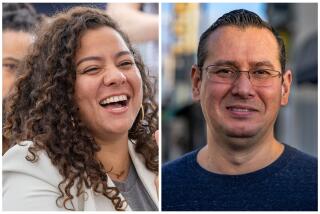The Mothers of East L.A. Transform Themselves and Their Neighborhood
They emerged from nowhere three years ago, 100 mothers with two things in common: a white scarf tied around their heads and a deep-seated concern for the health and safety of their East Los Angeles neighborhoods.
Galvanized by Father John Moretta of Resurrection Church to battle construction of a proposed $100-million state prison in East Los Angeles, the group of Latinas helped stall the project and have gone on to tackle issues ranging from environmental pollution to overcrowded classrooms.
In the process, they have transformed themselves and their neighborhoods, say community leaders and activists, who have come to regard the grass-roots organization called Mothers of East Los Angeles as a leader in local environmental issues.
“In other times, similar groups tackled issues such as the Vietnam War, police brutality and media representation of minorities,” said Rodolfo Acuna, professor of Chicano Studies at Cal State Northridge. “Right now, the Mothers are one of the few grass-roots groups in our community dealing with land use and quality of life issues.”
Los Angeles City Councilwoman Gloria Molina, a leading opponent of the Eastside prison, said of the group: “These are not losers who say, ‘Well, that’s the way the system treats us.’ They’ve learned not to be frightened or intimidated by people in power.”
Most of the Mothers were born and reared in East Los Angeles at a time when its low-income residents were afraid to fight government officials who railroaded disruptive projects--including freeways, prisons and dumps--through their community.
Guest Speakers
So too, many of the early members described themselves as shy housewives, easily unnerved by television cameras or government officials who berated their efforts to derail ostensibly economically beneficial projects. Today, the Mothers of East Los Angeles are guest speakers at seminars and community meetings from Los Angeles to Sacramento.
In a visual sign of their transformation, the membership last year replaced the white mantillas-- worn at marches and demonstrations as a symbol of their adherence to nonviolent principles--with spiffy T-shirts and buttons emblazoned with a scarlet logo of a woman embracing an infant.
This month, the group, which has 400 members and is supported by donations from relatives, friends and sympathetic merchants, is incorporating. The move will make it easier for them to raise money for demonstrations, candlelight vigils and letter-writing campaigns--tactics they use to pressure developers, politicians and bureaucrats.
“In the old days, if the government said, ‘Move on,’ people moved on,” said Lucy Ramos, a 40-year-old mother of five children and a spokeswoman for the group. She was a child when state officials ordered her family to leave their home to make way for one of several freeways that sliced through East Los Angeles in the 1950s, displacing 10,000 people and leaving behind a legacy of noise and pollution.
Reached the Limit
“It’s not that way any more,” she said. “There is a limit to how much junk they can dump on people, and this community has reached it.”
There are many other grass-roots organizations in East Los Angeles, some of which also have links to the Roman Catholic Church. The United Neighborhoods Organization, for example, claims a membership of 90,000 families from Catholic churches throughout East Los Angeles.
Unlike the tightly organized UNO, which has a paid staff and admittedly takes on only battles in which it has a reasonable chance of victory, the Mothers of East Los Angeles depends solely on volunteers and has chosen to focus on complex environmental and land-use issues.
“If you witness their persistence, their doggedness, you would see something very natural, something wholesome,” Moretta said. “They are mothers who have coalesced around something of immediate importance to them, the safety of their families and children.”
Over the last four years, the group has participated in efforts to block proposals to build a state prison in the middle of an area with 32 schools, a $29-million hazardous waste incinerator in the city of Vernon that would burn 225,000 tons of toxic waste a year and an above-ground pipeline that would carry oil from Santa Barbara to Long Beach through the heart of Boyle Heights.
Pipeline Stopped
The proposed pipeline was stopped two years ago when the Los Angeles City Council turned down permits requested by four oil companies.
In the case of the state prison proposal, intense grass-roots opposition prompted state officials to request additional study of the potentially adverse effects it would have on traffic, property values and character of neighborhoods in the area, state Department of Corrections officials said.
The proposed prison site is near the intersection of Washington Boulevard and Santa Fe Avenue, just west of the Los Angeles River.
“I think in terms of the state prison, they have had some degree of effectiveness in opposition to it,” acknowledged state Sen. Robert Presley (D-Riverside), chairman of a joint legislative committee on prison construction. “They had a letter-writing campaign and came to Sacramento a few times to demonstrate, which stimulated opposition among some legislators, particularly among legislators from Los Angeles County.”
Misguided Opposition
Ultimately, the effort did not dissuade the Legislature from authorizing the prison in a compromise worked out with Gov. George Deukmejian.
Presley insisted that the Mothers’ opposition to the project is misguided.
“I can understand opposition to a toxic waste incinerator, or a pipeline that could explode and injure somebody,” Presley said. “But in this case, for goodness sakes . . . the prison will provide hundreds of jobs, the building will look nice. We have even agreed to upgrade the streets surrounding it and to build a small park.”
“If Presley wants it so bad, he can put it his own back yard,” argued Aurora Castillo, the group’s self-described “town crier” and keeper of a list of 400 phone numbers used to share information with the membership on short notice. “Our concern is the possibility of escapes. No prison is escape-proof. There are just too many children in our area to risk it.”
Continuing Protests
In another effort by the Mothers, the group has joined the continuing protests against the hazardous waste incinerator in Vernon that figured in a recent South Coast Air Quality Management District decision requiring a full environmental impact report before it can be built. State health officials and the U.S. Environmental Protection Agency had earlier approved its construction without such a report.
A week ago, Security Environmental Systems Inc. won a decision in Los Angeles County Superior Court to overrule the AQMD requirement for an environmental impact report, provided that the company use the best available technology equipment. AQMD officials have appealed the decision.
Despite assurances of safety and promises of job opportunities by federal, state and company officials, the Mothers contend that their community is already saturated with nine detention facilities and that the incinerator could poison the air with toxic pollution.
Threat to Children
The group and its supporters believe that such projects pose a special threat to children in an area where 49% of the heavily Latino population of more than 100,000 is below age 25, compared with 36% elsewhere in the city.
For members such as Ramos, being part of the organization has required changes in the household routine and a major commitment of time.
In fact, Ramos had never flown in a jet airliner until Feb. 10, 1987, when she traveled to Sacramento to lobby against the plan to build the state prison. Roy Wolze, a Lincoln Heights hardware store owner and supporter of the Mothers, paid for her plane ticket.
“The kids in this house don’t ask, ‘What’s for dinner, Mom?’ They ask, ‘Where’s the meeting tonight?’ ” Ramos said. “Sometimes, you get tired of these meetings, but the work has to get done.”
Strain on the Family
The new commitments have placed a strain on the family, said Ramos’ husband, Jesse, a 42-year-old production worker at a local bakery.
“I support my wife even though it gets hectic,” he said. “Her political work involves going to meetings and demonstrations. Who gets stuck with the baby-sitting? Dad!”
Some members, however, came to the group with years of experience in political work gained at PTA meetings, Neighborhood Watch programs and United Farm Workers union boycotts.
Among them is Juana Gutierrez, a 57-year-old mother of nine children and leading activist in the Mothers who got her start in PTA and Neighborhood Watch organizing efforts. Gutierrez has not completed a high school education and speaks only Spanish. Two of her children have earned degrees from Princeton University.
‘Dangerous Projects’
“They want to put these things in our area because no other community will accept such dangerous projects and because we are poor and don’t have the influence of a Beverly Hills,” said Gutierrez, standing in a room of her modest Boyle Heights home reserved for the dozens of plaques and proclamations awarded her and her children over the years. “But we poor are also human beings with a desire to protect and improve our community.”
Gutierrez was among a loose-knit group of women first mobilized in 1984 when then-Assemblywoman Molina turned to her East Los Angeles constituents for support in blocking the state prison. The group responded to the call by collecting 900 signatures on a single Sunday from people at local churches opposed to the prison.
Weekly Meetings
Buoyed by their success, the women began to hold weekly meetings at Gutierrez’s home, where they immersed themselves in government documents, industry studies and impact reports dealing with the prison and a growing list of other projects they perceived as a danger to the community.
Gutierrez’s group was one of dozens that Moretta invited to a meeting at Resurrection Church in the summer of 1986 to organize a massive march against the prison. At that meeting, Moretta gave them a name.
“We are going to form an organization and I have a name for it,” Moretta told the women who stared expectantly from the pews. “But first you must tell me if the initials mean anything bad in Spanish. Is MELA a bad word?”
The women shook their heads in the negative.
Marching in the Streets
“Wonderful,” Moretta said as he handed each of them a scarf cut from white bedsheets purchased with church funds. “The name will be the Mothers of East Los Angeles.”
A few hours later, the women were marching in the streets and wearing the white scarfs, which would become their calling cards at demonstrations and legislative meetings.
Almost immediately, they caught the attention of more experienced community leaders who offered advice and financial assistance. Molina and Assemblywoman Lucille Roybal-Allard (D-Los Angeles) have provided technical information and political strategies.
East Los Angeles landscape architect Frank Villalobos and Lincoln Heights Chamber of Commerce President Steve Kasten, for example, have donated thousands of dollars to pay for bus fares, airplane tickets, food and even T-shirts.
More to Read
Sign up for Essential California
The most important California stories and recommendations in your inbox every morning.
You may occasionally receive promotional content from the Los Angeles Times.











